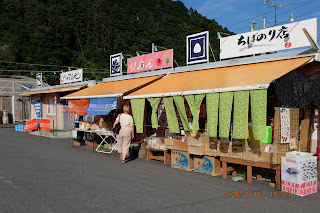Zuniho-Den Temple
Original stone lanterns
View of Sendai
Date Matsamuse
We next went to Adoba Castle. It was the castle of Date Matsamuse. It has since burned down, but there is a great view of Sendai from there and a wonderful statue of Date Matsamuse. We had lunch there and departed for our next destination.
We were to visit Minamisanriku, starting at a community center that is supported by the NGO Peace Winds Japan. This area was hit hard by the Tsunami in 2011. There are currently 18,000 residents in the area, but they lost 800 in the tsuami. The city is still rebuilding 5 years later. The community center we visited was established to give the older people in the community a place to gather and do something productive for the community. The group that was working consisted of 4 woman and one man. They are making floor tiles to sell using reclaimed materials. The tiles will be sold to support the communities recovery efforts. This is supported by the organization Peace Winds. They go into areas that have been hit by a disaster and work to help the people rebuild some community ties. They particularly work with the elderly in the community.
The tiled floor of the building
The town residents who are working on this project
Peace Wind's building, shipping containers put together to make a building
The extent of the devastation in the area was unbelievable. The entire town that wasn't on the hillside was washed away. Luckily the schools were on hills. There are still many residents living in temporary housing. They are rebuilding the main shopping areas of the town on man-made hills. They hope that these will be high enough to withstand another tsunami. The townspeople had warning that the waves would be 10 meters, but they ended up being 30 meters high. They anticipate that the rebuilding process will take another 5 years. Because the population of the town is on the older side, they have to bring in workers from Sendai to do the heavy labor.
One very moving experience was to see a structure that has been left in place amidst the rebuilding. It was the emergency disaster building for the town. Apparently the workers all stayed at their posts during the entire tsunami to help warn the townspeople. Sadly they all lost their lives as the huge waves swept through the town. The town has left the skeleton of the building in place as a reminder of those who lost their lives in order to save other lives. There is also a shrine there to those brave men and women.
View from the hill above town
Big white building will be housing for residents
Picture of a before and after picture
Chile sent this Moai statue since they are have a sister city. This was to help with healing. There was another statue that was lost during the Tsunami
Temporary shopping area in town
Emergency preparedness building
Japan is facing big challenges as it's population ages.
After that very sobering, but hopeful visit, we checked into our hotel in Sendai and headed out to dinner at a local restaurant. We have been eating well on this trip.





























































